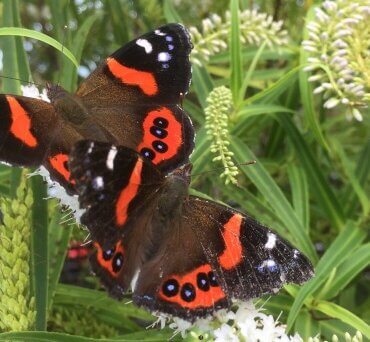
Red Admiral caterpillars from the King Country have been taken to Auckland in the hope they will revive a population devasted more than two decades ago.
Moths and Butterflies NZ Trust trustee Jacqui Knight said native red admiral butterflies disappeared from the city of sails following the government’s painted apple moth eradication campaigns in 2001 and 2002

Vanessa gonerilla NZ red admiral on Urtica australis. Photo: Brian Patrick
“This species is only located in New Zealand and was once widespread,” Knight said. “Development and the loss of our wild spaces also means that now the beautiful butterfly is a very infrequent visitor.”
There are other red admirals in the world, but the NZ red admiral, in te Reo ‘kahukura’ (meaning “red cloak”) was definitely the most beautiful, she said.
“It’s as much a part of NZ as our kiwi and kauri, but it seems to have been gone and forgotten here over the past 20 years.”
Moths and butterflies is hoping to re-start the Red Admirals in Auckland with a release on Monday of butterflies whose mum was taken from the QE2 covenanted part of the Stubbs family farm at Waitomo Caves. A female Red Admiral found on the first visit to the Stubbs farm laid her eggs all over the nettle the trust has grown in Auckland. The native tree nettle is where red admirals lay eggs.
 “Few people are brave enough to plant urtica ferox, the tree nettle or ongaonga, the host plant on which the species lays its eggs,” King said. “They can still support the campaign by providing more nectar flowers in their gardens.
“Few people are brave enough to plant urtica ferox, the tree nettle or ongaonga, the host plant on which the species lays its eggs,” King said. “They can still support the campaign by providing more nectar flowers in their gardens.
“We are campaigning this summer to increase awareness of this species and to encourage more people to plant nectar flowers and the butterfly’s host plant,” she said. “The butterflies are pollinators and both the adults and the caterpillars are a valuable ingredient in the diet of our native birds. If we are successful in bringing the red admirals back to Auckland, undoubtedly our birds will benefit too.”
On a more recent visit to Waitomo they returned with about 50 caterpillars, Knight said.
“We were hoping to get a female that was laying eggs but we ended up with caterpillars.”
The first preference was butterflies, the second caterpillars. Chrysalides were often paracitised by wasps, and eggs were hard to find, Knight said.
Biodiversity advisor to the MBNZT Brian Patrick said the butterfly was not so rare in the South Island because of the large number of host plants growing there in the wild.
“South Island butterflies are not well adapted to Auckland’s climate. By collecting some from Northland or the Waikato to establish the population they will have a better chance of survival,” he said.
Graeme Hill, Auckland writer and radio host, said people can help the butterflies survive by controlling wasps, especially paper wasps and vespula species.

Red Admirals. Photo: Brian Patrick








